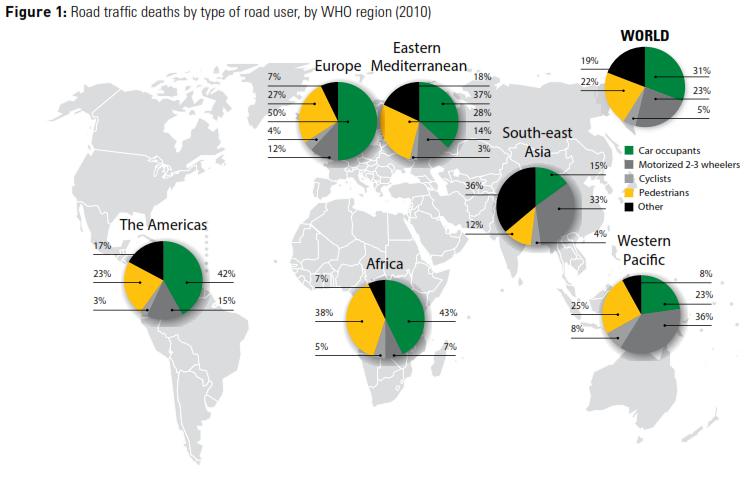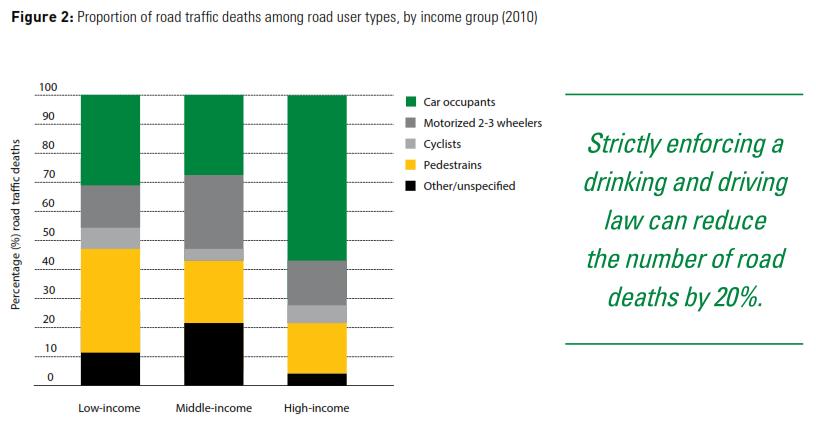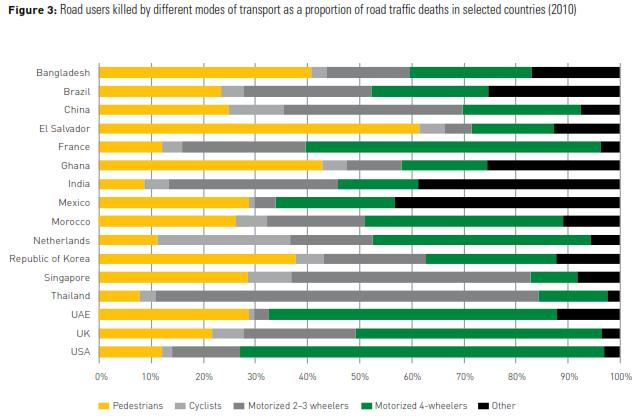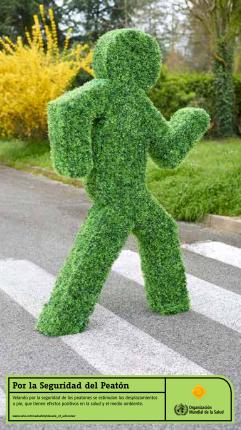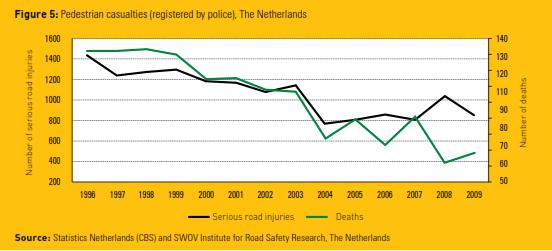Make walking safe - WHO 2013
A brief overview of pedestria safety around the world
Introduction
We are all pedestrians: on any given day – at a minimum – we begin and end most trips on foot. Yet due to a lack of attention to the needs of pedestrians, and a tendency to favour motorized transport, pedestrians are at risk of death, injury and disability. While there is no single measure to adequately address the range of risks to pedestrians across various settings, there are many steps that can be taken to improve their safety. The Decade of Action for Road Safety 2011–2020 offers a broad framework for drawing attention to the needs of pedestrians and putting in place the measures that exist to make walking safe. Ensuring the safety of pedestrians will encourage walking, which impacts positively on health and the environment. Among its many advantages, walking requires no fare, no fuel, no licence and no registration. It is integral to the livability and sustainability of our communities and should regain its place as a safe, convenient and pleasant option for most trips.
Who are killed and injured on the roads as pedestrians?
About 1.24 million road traffic deaths occur annually on the world’s roads, making road traffic injuries the eighth leading cause of death globally, and the leading cause of death for young people aged 15–29 years. Of the total road traffic fatalities, more than 270 000 are pedestrians. This constitutes 22% of all road deaths. Males, both children and adults, are over-represented in pedestrian collisions. In high-income countries, older pedestrians are more at risk of death and injury. Among the reasons for this include their decreased visual acuity, reduced reaction time, slower walking speed and frailty. In low-income and middle-income countries, younger pedestrians are more at risk. This is due in part to the size of children relative to vehicles, limitations in judgment in terms of the speed or distance of a vehicle, lack of attention to the surroundings, and failure of parents or others to adequately supervise them. Both children and adults with disabilities also suffer higher rates of injury as pedestrians compared to their non-disabled peers. In addition to deaths, millions more people are injured in traffic-related crashes while walking, some of whom become permanently disabled. The wide variation of pedestrian death and injury rates across countries underscores the need to develop a thorough understanding of the problem at national and local levels.
How are pedestrian deaths distributed around the world?
Regionally the proportion of pedestrians killed in relation to other road users is highest in the WHO African Region (38%) and lowest in the WHO South-East Asia Region (12%).
In general pedestrians tend to account for a greater proportion of road traffic injury deaths in low-income countries than in middleincome or high-income countries.
Fatality patterns vary considerably across settings. In some countries the proportion of pedestrians killed in relation to other road users is as high as two thirds. The following figure highlights this variation across countries.
Where and when do pedestrian collisions occur?
Overall, there is wide variation in locations of pedestrian collisions from one country to another. While pedestrian collisions occur more often on city streets in high-income countries, they occur more often on major roads between cities and rural areas in low-income and middle-income countries. Most pedestrian collisions happen when pedestrians are crossing the road, rather than walking or standing alongside the road. Worldwide, a high percentage of pedestrian deaths and injuries occur when lighting conditions are low, during dusk and dawn and at night.
What happens in a pedestrian collision?
Most road traffic crashes in which a pedestrian is struck by a vehicle involve a frontal impact. For an adult, the first contact usually occurs between the leg or knee and the vehicle’s bumper, followed by the thigh with the bonnet’s edge, and the pelvis or thorax with the bonnet’s top. The head then hits the bonnet or windscreen. Children, due to their smaller stature, are hit often at head or neck level. Most serious injuries are caused by the direct impact of the pedestrian by the striking vehicle itself rather than the road onto which the pedestrian falls. The severity of injuries sustained is influenced by the: vehicle impact speed; type of vehicle; shape and stiffness of the vehicle front; age and height of the pedestrian; and standing position of the pedestrian relative to the vehicle front.
84% of the roads in low-income
and middle-income countries
where pedestrians are present
carry traffic at 40 km/h and have
no footpaths (iRAP assessment).
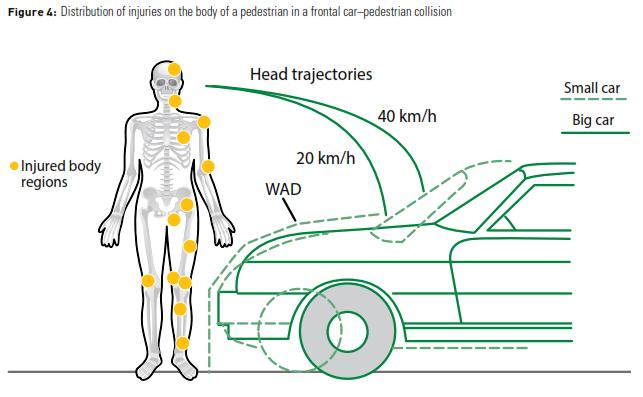
What are the consequences for injured pedestrians?
Cuando se ven envueltos en un accidente de ránsito, muchos peatones sufren lesiones y discapacidades graves. Pueden sufrir lesiones traumáticas del cerebro y la médula espinal, fracturas, sobre todo de los miembros inferiores, y laceraciones. Estas heridas a menudo requieren de una hospitalización prolongada y rehabilitaciones extensas. Los accidentes de tránsito son una carga enorme para los sistemas de salud. Aunque no se ha hechoun cálculo a nivel mundial de las repercusiones económicas específicas de las defunciones y lesiones de peatones, se estima que, en términos generales, los accidentes de tránsito cuestan a los gobiernos entre 1% y 3% de su producto nacional bruto, aunque esta cifra bien puede llegar hasta 6%. En vista de que a menudo matan, lesionan e incapacitan el sostén de la familia, y de que los
costos de la atención son elevados, los accidentes viales pueden llevar a las víctimas y sus familias a la pobreza.
¿Cuáles son los principales riesgos para los peatones?
Many varied types of road users exist. Pedestrians, cyclists, motorcyclists, and drivers of private and commercial vehicles share the same road space, moving various distances between places for personal, social and economic purposes. On any given day their use of the roads determines the traffic mix and volume, and hence the level of exposure to the risk of a road traffic crash. The interaction these road users have should not necessarily lead to road traffic deaths and injuries, but often does, because of a lack of road safety measures. A number of factors that increase a pedestrian’s exposure to risk are well documented, and they include issues related to a broad range of factors. Among these are:
Driver behaviour:
Speeding, drinking and driving, distracted driving and failing to respect a pedestrian’s right-of-way.
Pedestrian behaviour:
Alcohol-impaired walking, distracted walking, a lack of ability to be seen in certain conditions and failing to abide by road signs and signals.
Road design:
Failure to prioritize the needs of pedestrians in road design by providing safe, accessible, and comprehensive facilities and services, such as sidewalks, raised crossings, raised medians and inadequate roadway lighting.
Land-use planning:
Large distances between people’s homes, workplaces, schools, shops and other facilities, making for longdistance trips and failure to ensure that the roads and vehicles connecting these places are safe.
Vehicle design:
A lack of use of crash-protective safer vehicle fronts and emergency breaking systems as well as inadequate enforcement of current pedestrian-friendly vehicle design standards.
Trauma care:
Deficient systems for getting injured pedestrians the urgent medical treatment they need increase the risk for more severe consequences following a road traffic crash.
A 5% cut in average speed can
result in a 30% reduction in the
number of fatal crashes.
What measures can be taken to protect pedestrians?
There are many steps that can be taken to protect pedestrians on the roads. A detailed road safety assessment, with a component on pedestrian safety, would indicate which measures to prioritize in a particular setting. If implemented worldwide, these measures could make a significant and long-lasting contribution
to make walking safe.
Driver behaviour:
* Legislating and enforcing new and existing laws that:
- reduce speeding: a speed limit of 50 km/h or less on urban roads, which allows local authorities to further reduce these limits where appropriate, for example, to 30 km/h around schools;
- curb drinking and driving: enforcement of a Blood Alcohol Concentration (BAC) limit of 0.05 g/dl or less and even lower for novice drivers and random breath testing for all drivers;
- decrease mobile phone use and other forms of distracted driving;
- promote respect for the pedestrian’s right-of-way among vehicle drivers, motorcyclists and bicyclists;
*Informing the public through mass media campaigns about legislation and enforcement and the rights and
responsibilities of all road users.
In the United States, New York City’s
ambitious target of reducing annual road
traffic fatalities by 50% by 2030 aims to
save 1600 lives. To achieve this the city is
installing pedestrian countdown signals at
1500 intersections citywide; implementing
75 additional 20 mph (32 km/h) school
speed zones; developing a pilot programme
for neighbourhood 20 mph (32 km/h) zones;
enforcing speeding laws along major traffic
corridors; and using mass media campaigns
to engage and inform the public. Depending
upon the intervention, these measures have
been credited with reducing pedestrian
collisions and total crashes by 25–51%.
Pedestrian behaviour:
- Enacting and enforcing laws on public intoxication;
- Educating pedestrians about the value of wearing light- colored clothing and reflective materials;
- Urging pedestrians to abide by road signs and signals and the rules of the road generally to promote a culture of safety.
In South Africa, the Provincial Government
of the Western Cape leads the “Safely
Home” initiative, which seeks to reduce
road traffic fatalities by 50% by 2014. To
better protect pedestrians at particularly
hazardous locations, measures such as
controls on BAC for drivers, speed cameras,
pedestrian overpasses, and the “Crash
Witness” public awareness campaign have
been used, leading to a 29% reduction in
road traffic fatalities in three years. Social
media is also used to report reckless driving
behaviour.
Road design:
- Separating pedestrians from other traffic through sidewalks, raised crossings, overpasses, underpasses, refuge islands and raised medians;
- Lowering vehicle speeds through traffic calming measures such as speed bumps, rumble strips, chicanes and other road narrowing treatments;
- Improving roadway lighting including around pedestrian crossings.
- Removing obstacles that block the line of sight between pedestrians and vehicle drivers, motorcyclists and bicyclists, including parked cars;
- Creating pedestrian only zones in city centres by restricting vehicular access;
- Improving mass transit route design;
- Using infrastructure solutions to enhance safety for school children on their routes to and from school.
In New Delhi, India, pedestrian fatalities
account for 45%-51% of all road traffic
deaths. In 2006, the city government
introduced a 5.8-km bus rapid transit
system. Integrated into its design were
measures such as raised five-metre wide
crossings; rumble strips; automatic traffic
signals and holding areas for pedestrians
and street vendors at intersections; and a
one-metre high fence along the bus route.
New road design guidelines and standards
take into account the safety needs of
pedestrians.
Land-use planning:
- Designing or redesigning cities in such a way that people’s homes, workplaces, school, shops and other facilities are in close proximity;
- Ensuring that land-use planning provides safe and continuous pedestrian facilities and services.
The municipality of Freiburg, Germany has
lowered the speed limit to 30 km/h on 90%
of its streets. Legislating and enforcing a
single speed limit for an entire geographical
area is likely to be more effective than
varying speed limits based on which a driver
may encounter three or four different speed
limits in a single trip. Additional design
features such as traffic calming measures
and rows of trees placed between roads
and sidewalks have been used. The effect
of this strategy is that 24% of trips every
day are on foot, 28% by bicycles, 20% by
public transport and 28% by car.
Vehicle design:
- Developing and enforcing vehicle design standards for pedestrian protection;
- Publicizing consumer information on pedestrian safety by make and model of car, for example, through New Car Assessment Programmes, to help generate a demand for safety from the public.
Trauma care:
- Organizing and/or further enhancing trauma care systems to guarantee the prompt treatment of those with life-threatening injuries, for example, through improved ambulance services or nationwide emergency telephone numbers;
- Ensuring timely and comprehensive rehabilitation services.
Conclusion
Pedestrian safety is a shared responsibility. All road users have a role to play in better protecting pedestrians and making the world safe for walking – even pedestrians themselves. Yet it is governments and their partners that are best placed to draw attention to the specific needs of pedestrians, legislate and enforce laws and standards for their protection, and design built environments in such a way that prevents pedestrian deaths and injuries and encourages walking. Advocacy groups can also have a significant role in fostering the conditions that make walking safe, by generating public demand for pedestrian safety; mobilizing action particularly at local level; and championing the right to safety for all road users, including children, the elderly and people with disabilities who are among the most vulnerable pedestrians. Effective interventions exist to better protect pedestrians, and implementation of these should utilize a comprehensive approach that focuses on a combination of engineering, enforcement and education. Such actions will contribute to a culture of safety, make walking safe, and, ultimately, save pedestrian lives.
For decades the Netherlands has made great strides in reducing pedestrian fatalities and injuries
on the nation’s roads. Road design measures such as construction of 30 km/h zones and raised,
highly visible and uniform crossings; vehicle measures such as pedestrian-friendly car fronts; and
information and education around behavioural measures such as those related to drinking and
driving and speeding have increased the safety of pedestrians. Paying particular attention to the
specific needs of children and the elderly has also contributed to the decline in pedestrian fatalities and injuries. Fostered by government, the citizens of the Netherlands have accepted and supported the notion of a culture of safety, and this progress in protecting pedestrian lives is evidence of an overall focus on safety across society.
Related documents
Pedestrian safety: a road safety manual for decision-makers and practitioners (2013)
Global status report on road safety 2013 (2013)
Mobile phone use: a growing problem of driver distraction (2011)
Data systems: a road safety manual for decision-makers and practitioners (2009)
Speed management: a road safety manual for decision-makers and practitioners (2008)
Drinking and driving: a road safety manual for decision-makers and practitioners (2007)
Youth and road safety (2007)
World report on road traffic injury prevention (2004)
Source:
www.who.int/violence_injury_prevention/publications/road_traffic


